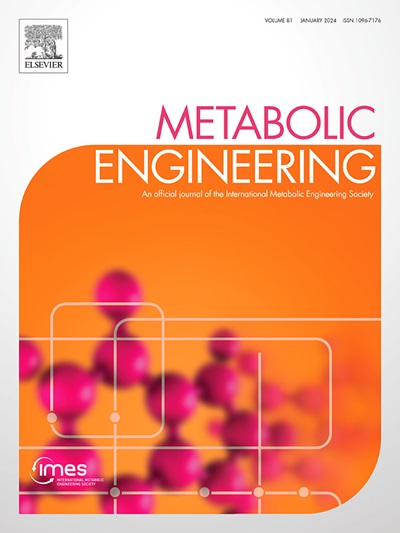基因组尺度的过表达筛选揭示了膜稳态是大肠杆菌游离脂肪酸过量产生的关键决定因素。
IF 6.8
1区 生物学
Q1 BIOTECHNOLOGY & APPLIED MICROBIOLOGY
引用次数: 0
摘要
由于细胞代谢的高度复杂和相互关联的性质,基因组尺度的目标鉴定对于优化微生物生物合成是必不可少的。游离脂肪酸(FFAs)是生物燃料和工业化学品的宝贵前体,在大肠杆菌中得到了广泛的研究。然而,对促进FFAs产生的有益靶点的全基因组探索仍然有限,阻碍了充分释放微生物生物合成能力潜力的努力。在这项研究中,我们利用ska (A Complete Set of E. coli K-12 ORF Archive)文库,结合荧光活化细胞分选(FACS)和下一代测序(NGS),对大肠杆菌中FFAs过量产生的上调靶点进行了基因组规模的筛选。我们发现,编码脂多糖(LPS)核心heptose II磷酸激酶的rfaY过表达通过增强膜稳定性导致FFAs产量增加207.8%,这可以通过降低通透性和提高完整性来证明。进一步的研究表明,过表达额外的LPS生物合成相关基因同样提高了膜的健壮性和FFAs的产生。通过反复筛选,yafL和rimM被确定为与rfaY具有协同作用的伙伴,随后整合fadR过表达最终获得了最佳菌株rfaY+-yafL+-fadR+,该菌株在补料分批发酵下的FFAs滴度达到了39.6 g/L,这是迄今为止在大肠杆菌中报道的最高滴度。这项研究强调了基因组规模挖掘潜在遗传决定因素对增强所需产品的生物合成的重要性。本文章由计算机程序翻译,如有差异,请以英文原文为准。
Genome-scale overexpression screen reveals membrane homeostasis as a key determinant for free fatty acids overproduction in Escherichia coli
Genome-scale target identification is essential for optimizing microbial biosynthesis due to the highly complex and interconnected nature of cellular metabolism. Free fatty acids (FFAs), valuable precursors for biofuels and industrial chemicals, have been extensively studied in Escherichia coli. However, genome-wide exploration of beneficial targets that promote FFAs production remains limited, hindering efforts to fully unlock the potential of microbial biosynthetic capabilities. In this study, we performed genome-scale screening of upregulation targets for FFAs overproduction in E. coli by leveraging the ASKA (A Complete Set of E. coli K-12 ORF Archive) library in combination with fluorescence-activated cell sorting (FACS) and next-generation sequencing (NGS). We found that overexpression of rfaY, encoding a lipopolysaccharide (LPS) core heptose II phosphokinase, led to a 207.8% increase in FFAs production by enhancing membrane stability, as evidenced by reduced permeability and improved integrity. Further investigation revealed that overexpressing additional LPS biosynthesis-related genes similarly improved membrane robustness and FFAs production. Through iterative screening, yafL and rimM were identified as synergistic partners with rfaY, and subsequent integration of fadR overexpression ultimately yielded the optimal strain rfaY+-yafL+-fadR+, which achieved a FFAs titer of 39.6 g/L under fed-batch fermentation—the highest reported to date in E. coli. This study highlights the significance of genome-scale mining potential genetic determinants for enhancing the biosynthesis of desired products.
求助全文
通过发布文献求助,成功后即可免费获取论文全文。
去求助
来源期刊

Metabolic engineering
工程技术-生物工程与应用微生物
CiteScore
15.60
自引率
6.00%
发文量
140
审稿时长
44 days
期刊介绍:
Metabolic Engineering (MBE) is a journal that focuses on publishing original research papers on the directed modulation of metabolic pathways for metabolite overproduction or the enhancement of cellular properties. It welcomes papers that describe the engineering of native pathways and the synthesis of heterologous pathways to convert microorganisms into microbial cell factories. The journal covers experimental, computational, and modeling approaches for understanding metabolic pathways and manipulating them through genetic, media, or environmental means. Effective exploration of metabolic pathways necessitates the use of molecular biology and biochemistry methods, as well as engineering techniques for modeling and data analysis. MBE serves as a platform for interdisciplinary research in fields such as biochemistry, molecular biology, applied microbiology, cellular physiology, cellular nutrition in health and disease, and biochemical engineering. The journal publishes various types of papers, including original research papers and review papers. It is indexed and abstracted in databases such as Scopus, Embase, EMBiology, Current Contents - Life Sciences and Clinical Medicine, Science Citation Index, PubMed/Medline, CAS and Biotechnology Citation Index.
 求助内容:
求助内容: 应助结果提醒方式:
应助结果提醒方式:


